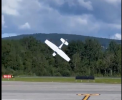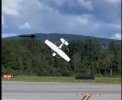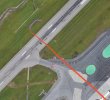Been there, done that, but with better training in the Cessna family of light planes.
douglas 393 posted after I read the previous, and I fully agree with his theory. Flaps are deployed before the walk around, and retracted after the pilot is in the seat. Retracting may well have been missed. Flight aware may have missed a trip around the pattern prior to this take off.
150/152 and 172's, configured for landing with flaps 20 or more, will pitch up rapidly when full power is applied for a go around. It takes a strong pilot to overcome those forces on the yoke.
This may have been a young pilot, a small pilot, or an old geezer like me, with modest arm strength to overcome those forces.
My training called for pushing hard on the yoke while simultaneously spinning the trim wheel nose down with the other hand.
Alternately, it there were no obstacles ahead, reduce power to about half throttle. This reduced thrust below the drag from the flaps.
As soon as the plane was in a stable flight condition, bring the flaps up slowly.
The first 150 that I trained in had the Johnson Bar flaps, and if the setting was more than 20, they were reduced immediately to 20, then as control became normal, the rest of the flaps returned to 0 as fast as safe airspeed allowed.
With electric flaps, they are slow, and require an extra hand, so either trim wheel or throttle are important first responses.
The accident plane had plenty of runway ahead, so reducing power was a safe option.
This may not have been a go around, but just a flaps landing, taxi back, and take off with the flaps still down, and normal takeoff trim. Rotation would have been immediate, and steep, with a pilot who had never had a plane do such before, and mentally unprepared for a logical interpretation of the cause.
Do you visually check your flaps before EVERY takeoff? I think that I do, and it was one of my normal checks, in all brands of aircraft. If I missed that check, it was after a no flaps landing, which would simply make me a lucky pilot.
I have a lot of sympathy for this pilot, I have seen 2 Cessna's crash in a similar manner during a go around with flaps greater than 10 degrees. Both survived, as these crashes take place at very low altitude and speed. I was young then, and did run to the crash, to assist the pilots out. Both were early solo flights, one with the instructor there watching. He was the first to the plane.
I have no opinion for the camera person's non reaction to the crash, but their video did document the event well, and we should all applaud them for that. It is important that each of us do our thing well. The tower and line crew are there to take care of on airport events.
As an early fan of seat belts in cars, self installed before they were available from the factory, and retrofitted shoulder strap as soon as they were STCed for our planes, yes, that is why we do not have a serious injury or fatality here.






